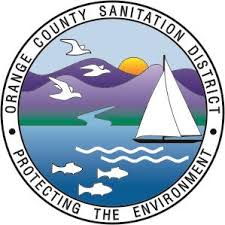Orange County Sanitation District Engages in Wastewater Based Epidemiology
 The wastewater sector is emerging as a valuable resource to cost-effectively monitor the COVID-19 pandemic through Wastewater Based Epidemiology (WBE). Influent monitoring for viruses is not a new concept. This approach been used for many years to monitor for other viruses of concern such as Polio and SARS, and when employed in collaboration with public health officials, can serve as a reliable indicator of community infection rates. By analyzing influent wastewater, we can monitor trends in real-time, evaluate the community-based presence of the virus through indicators, calculate infection rates, prioritize focus areas, and observe the impacts of shelter-in-place orders. Monitoring the virus responsible for COVID-19 (SARS-CoV-2) in wastewater can provide public health and medical professionals with a leading indicator of anticipated infection dynamics. As interest in WBE increases, the CDC, USEPA, leading universities, and research outlets are beginning to coordinate efforts, and we anticipate rapid expansion of these projects in the next several months.
The wastewater sector is emerging as a valuable resource to cost-effectively monitor the COVID-19 pandemic through Wastewater Based Epidemiology (WBE). Influent monitoring for viruses is not a new concept. This approach been used for many years to monitor for other viruses of concern such as Polio and SARS, and when employed in collaboration with public health officials, can serve as a reliable indicator of community infection rates. By analyzing influent wastewater, we can monitor trends in real-time, evaluate the community-based presence of the virus through indicators, calculate infection rates, prioritize focus areas, and observe the impacts of shelter-in-place orders. Monitoring the virus responsible for COVID-19 (SARS-CoV-2) in wastewater can provide public health and medical professionals with a leading indicator of anticipated infection dynamics. As interest in WBE increases, the CDC, USEPA, leading universities, and research outlets are beginning to coordinate efforts, and we anticipate rapid expansion of these projects in the next several months.
We reached out to the Orange County Sanitation District (OCSD), which has recently elected to participate in multiple WBE studies, to find out more about their efforts and to get a sense of how WBE is implemented on the ground level.
“Early on, we recognized that we would need expert advice on whether OCSD should initiate surveillance testing, and if so, how to design a robust study that can accommodate multiple use cases as the pandemic progressed,” said Lan Wiborg, OCSD’s Director of Environmental Services. The agency reported receiving several requests for sampling when WBE began circulating in the news media, but some of the requests lacked key information for how the samples would be used, and there appeared to be many duplicative efforts. After doing some initial research into what testing was available and how the data could be used, as well as confirming best practices, OCSD then initiated sampling in April for the three projects they decided to engage in at this time.
Together with the California State Water Resources Control Board, the University of Arizona’s Water and Energy Sustainable Technology Center (UofA WEST), and Stanford University and the University of Michigan, OCSD is now involved in three separate efforts to utilize WBE to inform public health decisions. Each study requires sampling of wastewater influent at various intervals based on study objectives. Samples are retrieved, documented and frozen, and then shipped off to the respective partners for evaluation and analysis.
The State Water Resources Control Board’s “Coronavirus Testing during DPR-2 Pathogen Monitoring Campaign”, a 14-month study, looks at the concentration of key pathogens and select indicators in raw wastewater. This study was originally commissioned by the Water Board to inform the development of uniform water recycling criteria for direct potable reuse through raw water augmentation, and sampling had been underway since December 2019. Soon after COVID-19 was characterized as a pandemic by the World Health Organization, the SWRCB requested the expansion of this study to include COVID-19 monitoring in the samples provided to date, including future samples The data may be used by local, state, and federal health officials to improve understanding of COVID-19 epidemiology.
The second project is a collaboration between OCSD and the University of Arizona’s WEST Center and is funded by OCSD. The objectives of the study include providing information on community prevalence and trends, occupational safety, and confirmation of effective removal of SARS-CoV-2 by wastewater and solids treatment.
Finally, OCSD was approached by researchers from Stanford University and the University of Michigan and agreed to begin providing samples for their research effort in early April. The Stanford/Michigan study consists of 3 objectives:
- Refining methods for determining the presence, concentration, and diversity of coronaviruses in wastewater influent and primary settled solids. The methods will then be applied to WWTP samples.
- Compare the data collected in objective 1 to the COVID-19 prevalence in areas served by the WWTPs.
- Develop a model that links SARS-CoV-2 concentrations in wastewater influent and settled solids to prevalence in the population.
These studies may help to answer questions about the spread and status of the new disease in a given area. If SARS-CoV-2 behaves similarly in wastewater when compared to coronaviruses that were previously studied, these studies may be able to approximate the number of infections within the community and use the measured concentrations to determine whether the outbreak is on the upswing, downswing, or a plateau.
Participation in all three of these projects is very much in line with OCSD’s vision and mission. “OCSD has been a nationally recognized leader in wastewater and environmental research for over sixty-five years and is proud of its history of successful collaborations with universities, research institutions, industry partners, and government agencies,” said General Manager Jim Herberg.
OCSD will continue to evaluate and consider additional proposals as they arrive. OCSD is hopeful that these studies will produce reliable and actionable data that could be used to support local public health actions. They plan to reach out to local public health agencies once they begin to receive validated and representative data. For agencies interested in getting started in one of these studies, their team recommends being selective when responding to requests for samples, identifying potential use cases, follow the best sampling and analytical practices, and ensuring that your agency can sustain an ongoing commitment to these projects. Additionally, OCSD has developed a research intake form to facilitate evaluating requests for sampling, sponsorship, and collaboration, which other agencies may find useful.
Overall OCSD reports that they’ve been able to stay at least half a step ahead of the COVID-19 headlines, noting collaboration and timely information sharing with clean water partners such as CASA, NACWA, CWEA, WRF, and SCAP. They also acknowledged their dedicated staff and leadership for going the extra mile in trying conditions.
If your agency is interested in getting involved in WBE, please reach out to Greg Kester who is coordinating WBE efforts with a variety of research institutions and the California wastewater community.
For the full interview with OCSD please follow this link: CASA-OCSD Interview
Special thanks to Jennifer Cabral and Lan Wiborg for their contributions to this content.
Have an interesting project you think would be a good feature in a future edition of CASA Connects? Contact Alyssa Downs to discuss being featured in our “Agency Spotlight” series.




 @CASA_CleanWater
@CASA_CleanWater